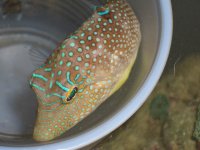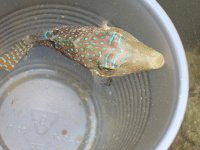You are using an out of date browser. It may not display this or other websites correctly.
You should upgrade or use an alternative browser.
You should upgrade or use an alternative browser.
FREE Puffer to a good home!
- Thread starter stingnyc
- Start date
info from Deans link...
These tobies feed most on algae, followed by an array of benthic invertebrates, such as tunicates and small crustaceans. Tube worms, foraminiferans, fish parts, and coral are also consumed to a lesser degree. They are reported to neatly nip off the tips of small-polyped stony (e.g. Acropora spp.) and alcyonarian corals with its strong fused teeth.
Tobies will eat a wide variety of chopped, fresh seafood, flake foods and frozen preparations. It is very important to feed these fish at least twice a day, especially in tanks that lack plant growth or sessile invertebrates. If fed any less than this, these fishes will loss weight. Tobies do best when housed in a tank that has an abundance of fleshy or filamentous algae, on which they can browse throughout the day. Because they are omnivores, it is important to include sufficient quantities of plant material in their diets, including algae, spinach, dried algae and frozen and/or flake foods formulated for herbivores. Tobies should also be housed in a tank with some hard calcareous decor that they can nip at or the aquarist can add a small piece of live rock now and then for them to chew on. This will help ware down their teeth, which will continue to grow and can get so long that they interfere with their normal feeding behavior.
Gregory Schiemer also reports having kept C. papua in a reef tank without incident. But these fishes do occasionally feed on SPS corals in the wild, as well as other ornamental invertebrates. For example, I have seen C. solandri bite off the feeding tentacles of Christmas tree worms (Spirobranchus spp.), the tips of serpent star arms, the skin knobs of sea stars and the spines of sea urchins. Therefore, if you add a toby to your reef tank, be aware that there is a possibility that they may damage sessile and motile invertebrates. One important thing to remember, is that they are less likely to cause problems if you feed them frequently (e.g., two or three times a day). One way to provide a more constant food supply, and possibly prevent them from biting your ornamental invertebrates, is to regularly add some of the freeze-dried algae sheets in a lettuce clip.
Although it can break the ice at parties, provoking your toby to inflate is not a good puffer maintenance practice. This will stress your fish and it could prove to be fatal if your toby ingests air. Tobies sometimes have difficulty expelling air from the stomach and end up bobbing helplessly at the water's surface. Another word of warning; these fish are not strong swimmers, so make sure all siphons tubes have strainers or small specimens may end up in your power filter.
These tobies feed most on algae, followed by an array of benthic invertebrates, such as tunicates and small crustaceans. Tube worms, foraminiferans, fish parts, and coral are also consumed to a lesser degree. They are reported to neatly nip off the tips of small-polyped stony (e.g. Acropora spp.) and alcyonarian corals with its strong fused teeth.
Tobies will eat a wide variety of chopped, fresh seafood, flake foods and frozen preparations. It is very important to feed these fish at least twice a day, especially in tanks that lack plant growth or sessile invertebrates. If fed any less than this, these fishes will loss weight. Tobies do best when housed in a tank that has an abundance of fleshy or filamentous algae, on which they can browse throughout the day. Because they are omnivores, it is important to include sufficient quantities of plant material in their diets, including algae, spinach, dried algae and frozen and/or flake foods formulated for herbivores. Tobies should also be housed in a tank with some hard calcareous decor that they can nip at or the aquarist can add a small piece of live rock now and then for them to chew on. This will help ware down their teeth, which will continue to grow and can get so long that they interfere with their normal feeding behavior.
Gregory Schiemer also reports having kept C. papua in a reef tank without incident. But these fishes do occasionally feed on SPS corals in the wild, as well as other ornamental invertebrates. For example, I have seen C. solandri bite off the feeding tentacles of Christmas tree worms (Spirobranchus spp.), the tips of serpent star arms, the skin knobs of sea stars and the spines of sea urchins. Therefore, if you add a toby to your reef tank, be aware that there is a possibility that they may damage sessile and motile invertebrates. One important thing to remember, is that they are less likely to cause problems if you feed them frequently (e.g., two or three times a day). One way to provide a more constant food supply, and possibly prevent them from biting your ornamental invertebrates, is to regularly add some of the freeze-dried algae sheets in a lettuce clip.
Although it can break the ice at parties, provoking your toby to inflate is not a good puffer maintenance practice. This will stress your fish and it could prove to be fatal if your toby ingests air. Tobies sometimes have difficulty expelling air from the stomach and end up bobbing helplessly at the water's surface. Another word of warning; these fish are not strong swimmers, so make sure all siphons tubes have strainers or small specimens may end up in your power filter.
This fish are great, they have great personalities but man they are really dumb! i have had a few over the years, some without incident and others that just ate everything. One took about 20 chunks out of my toadstool leather in just a few days before i caught it in the act. another one kept wandering into my anemone and getting stung - never fatally, he just looked like a cow getting shocked on an electric fence. but he never learnt he just kept getting stung.







